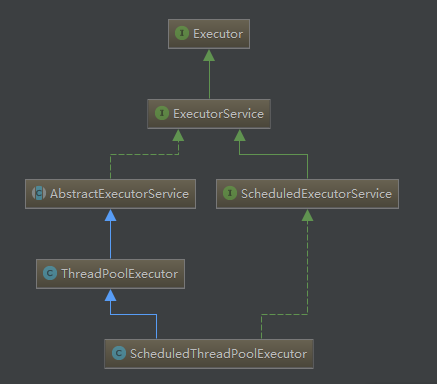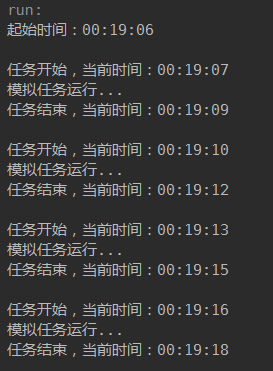在现实世界里,我们总是免不了要定期去做一件事情(比如上课)—— 在计算机的世界里,更是如此。比如我们手机每天叫我们起床的电子闹钟,某些网站会定期向我们发送一些推荐相关的邮件,集群中我们需要每隔一定时间检查是否有机器宕机等。
在 使用线程池 中已经介绍,JDK 1.5 时,标准类库添加了对线程池的支持,然后在线程池核心实现 ThreadPoolExecutor 的基础上,实现了 ScheduledThreadPoolExecutor,作为可以 定时和周期性执行任务 的线程池。ScheduledThreadPoolExecutor 的类图如下:
ScheduledThreadPoolExecutor 实现了 ScheduledExecutorService 接口,ScheduledExecutorService 继承了 ExecutorService 接口,所以首先 ScheduledThreadPoolExecutor 是一个 ExecutorService (线程池),然后除了具有线程池的功能,它还有定时和周期性执行任务的功能。ScheduledExecutorService 除了从 ExecutorService 继承的方法外,还包括如下四个方法:
第一个 Schedule 方法:
delay 指定的时间后,执行指定的 Runnable 任务,可以通过返回的 ScheduledFuture<?> 与该任务进行交互。
第二个 Schedule 方法:
delay 指定的时间后,执行指定的 Callable<V> 任务,可以通过返回的 ScheduledFuture<V> 与该任务进行交互。
(ScheduledFuture 接口 继承自 Future 接口,所以 ScheduledFuture 和任务的交互方式与 Future 一致。所以通过ScheduledFuture,可以 判断定时任务是否已经完成,获得定时任务的返回值,或者取消任务等)
scheduleAtFixedRate 方法:
initialDelay 指定的时间后,开始按周期 period 执行指定的 Runnable 任务。
假设调用该方法后的时间点为 0,那么第一次执行任务的时间点为 initialDelay,第二次为 initialDelay + period,第三次为 initialDelay + period + period,以此类推。
scheduleWithFixedDelay 方法:
initialDelay 指定的时间后,开始按指定的 delay 延期性的执行指定的 Runnable 任务。
假设调用该方法后的时间点为 0,每次任务需要耗时 T(i)(i 为第几次执行任务),那么第一次执行任务的时间点为 initialDelay,第一次完成任务的时间点为 initialDelay + T(1),则第二次执行任务的时间点为 initialDelay + T(1) + delay;第二次完成任务的时间点为 initialDelay + (T(1) + delay) + T(2),所以第三次执行任务的时间点为 initialDelay + T(1) + delay + T(2) + delay,以此类推。
我们来实践下 ScheduledThreadPoolExecutor 的 scheduleAtFixedRate 方法:
public class ScheduledExecutorServiceTest {
public static void main(String[] args) throws Exception {
ScheduledExecutorService timer = Executors.newSingleThreadScheduledExecutor();
TimerTask timerTask = new TimerTask(2000); // 任务需要 2000 ms 才能执行完毕
System.out.printf("起始时间:%s\n\n", new SimpleDateFormat("HH:mm:ss").format(new Date()));
// 延时 1 秒后,按 3 秒的周期执行任务
timer.scheduleAtFixedRate(timerTask, 1000, 3000, TimeUnit.MILLISECONDS);
}
private static class TimerTask implements Runnable {
private final int sleepTime;
private final SimpleDateFormat dateFormat;
public TimerTask(int sleepTime) {
this.sleepTime = sleepTime;
dateFormat = new SimpleDateFormat("HH:mm:ss");
}
@Override
public void run() {
System.out.println("任务开始,当前时间:" + dateFormat.format(new Date()));
try {
System.out.println("模拟任务运行...");
Thread.sleep(sleepTime);
} catch (InterruptedException ex) {
ex.printStackTrace(System.err);
}
System.out.println("任务结束,当前时间:" + dateFormat.format(new Date()));
System.out.println();
}
}
}
运行结果:
可以看到运行结果完全符合预期 —— 延时 1 秒后,每隔 3 秒执行一次任务。
上面是任务的运行时间小于周期时间的情况 —— 那如果任务运行的时间大于给定的执行周期呢?(比如任务运行需要 3 s,但是我们指定的周期为 2 s)
修改 main 方法:
public static void main(String[] args) throws Exception {
ScheduledExecutorService timer = Executors.newScheduledThreadPool(2);
TimerTask timerTask = new TimerTask(3000); // 每个任务需要 3000 ms 才能执行完毕
System.out.printf("起始时间:%s\n\n", new SimpleDateFormat("HH:mm:ss").format(new Date()));
timer.scheduleAtFixedRate(timerTask, 1000, 2000, TimeUnit.MILLISECONDS);
}运行结果:
可以看到此时虽然我们指定的周期为 2 s,但是因为任务的运行就需要 3 s(超过周期),所以这种情况下 scheduleAtFixedRate 的处理方式为 上一次任务刚完成,则紧接着立即运行下一次任务,而不是使用线程池中的空闲线程来运行任务以维护 2 秒这个周期 —— 由此可见,每个定时任务在 ScheduledThreadPoolExecutor 中,都是串行运行的,即下一次运行任务一定在上一次任务结束之后。
(scheduleWithFixedDelay 方法 的使用也十分简单,请有兴趣的读者自己实践)








**粗体** _斜体_ [链接](http://example.com) `代码` - 列表 > 引用。你还可以使用@来通知其他用户。